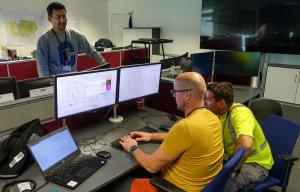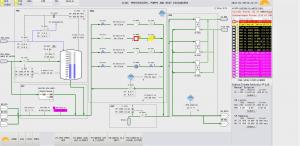The (temporary) main control room is operating
In November 2022, "ongoing operations" started in the temporary main control room. This important milestone is another sign of the progress in systems commissioning.
Since going live in Room 2016 of the ITER Headquarters building, the temporary main control room (T-MCR) is staffed by operators from ITER's Science, Controls & Operation Domain (SCOD)—one works in the morning and another in the afternoon. Start and end times depend on workloads, and may be adjusted—but in principle at least, the room is in use every workday from 8 a.m. to 5 p.m. Each operator works about five hours, including a short handover period during which the two operators exchange information on the status of different systems and ongoing activities.
The T-MCR had already been used from time to time to start up new equipment. For example, in November 2019, it was used to connect ITER's pulse powered transformer to the French power grid. But beginning what the specialists call "remote operations" marks a significant step. Since 16 November 2022, 13 remote operators have been taking turns running plant systems from the temporary main control room, using the same CODAC workstation—with the same human-machine interface—that will be moved to the main control room when it opens in the Control Building.
SCOD operators are already fulfilling several functions from the T-MCR. The first is to help commission the systems that have been transferred to the Science Controls & Operations Domain. "Tasks that we perform to help commission the secondary water loops, the heat rejection system, and liquid and gas systems include starting and stopping pumps and reaching target flow rates," says Andrei Badmaev, shift operator. "We also monitor pressure and temperature levels. We follow commissioning test procedures based on the manufacturer's datasheet for a given set of equipment. Most of the time, everything is fine, so at the end of the day, we stop the pumps and return everything to a safe condition."
"This is a good opportunity for us to train on systems before they move from commissioning to operation and to coordinate with operators in the field," says Benoît Chatelain, group leader in the Science Controls & Operations Domain. "Remote operators never start a pump without assistance from an operator in the field, for example. Likewise, operators in the field get used to working with operators in the T-MCR."
Today, SCOD operators run several systems and sub-systems from the T-MCR. The compressed air and demineralized water units are operated daily to support activities on the ITER platform. Compressed air is supplied at 9.3 barg to the cryoplant buildings and the Assembly Hall to support commissioning and construction, respectively. Demineralized water flows up to the building for reactive power control to supply the secondary cooling water loop.
Working from the T-MCR, SCOD operators help ensure safe and reliable service to cool cryoplant equipment for ongoing commissioning activities. Up to 4 MW thermal are withdrawn from the cryoplant thanks to the secondary cooling water loop. In the near future, SCOD Operators will serve additional clients in commissioning—including the coil power supply and electron cyclotron heating systems.
"We do more than just support operators in the field," explains Vladislav Kim, principal shift operator for SCOD. "We also serve as coordinators between different groups in unusual situations, such as emergency response and safety interventions."
"Not only do we test, commission and operate equipment, but we also work on procedures for handovers, and on the interaction between people in the field and the person in the control room," says Chatelain. "This is our chance to fine tune the procedures that will be used when the main control room goes live."
The T-MCR will continue operating from ITER Headquarters until the main control starts up in the Control Building.



